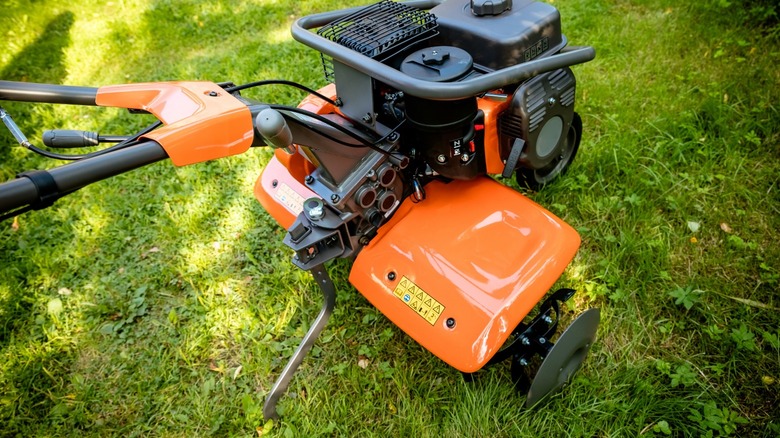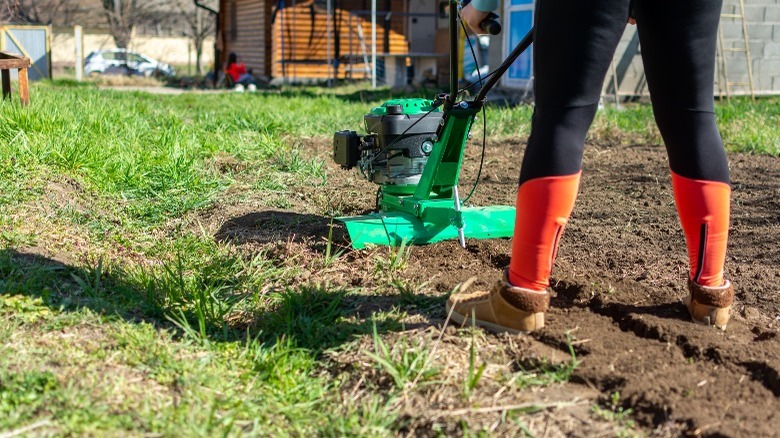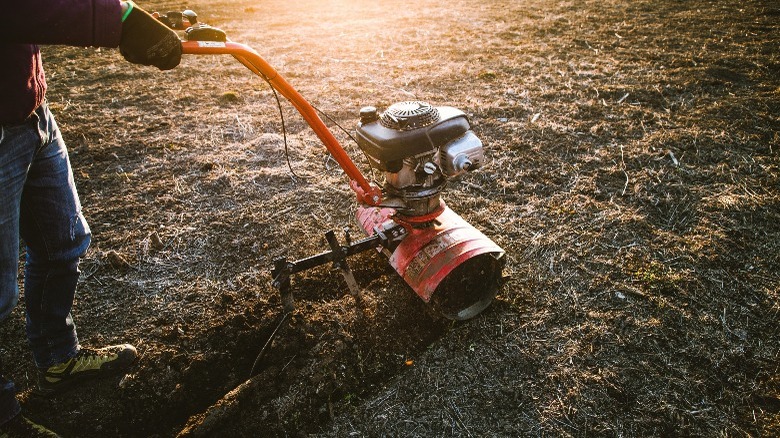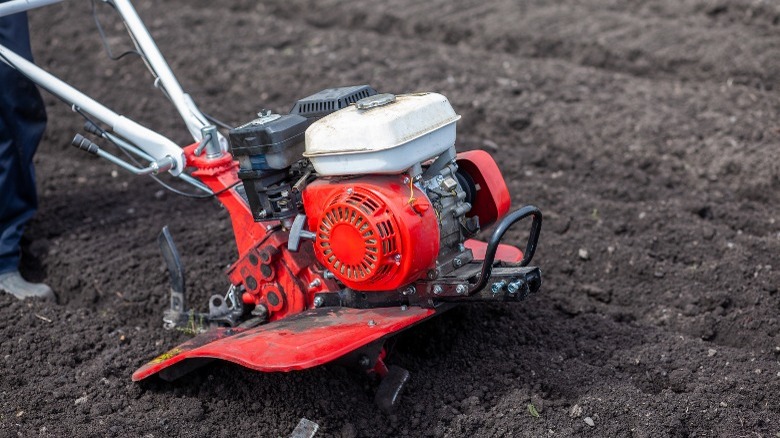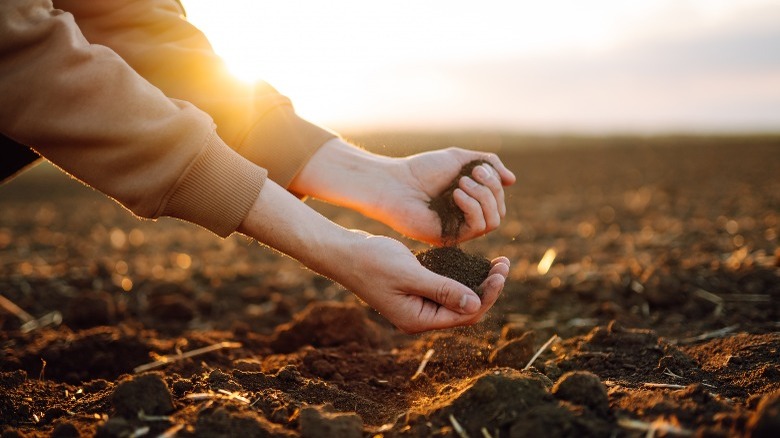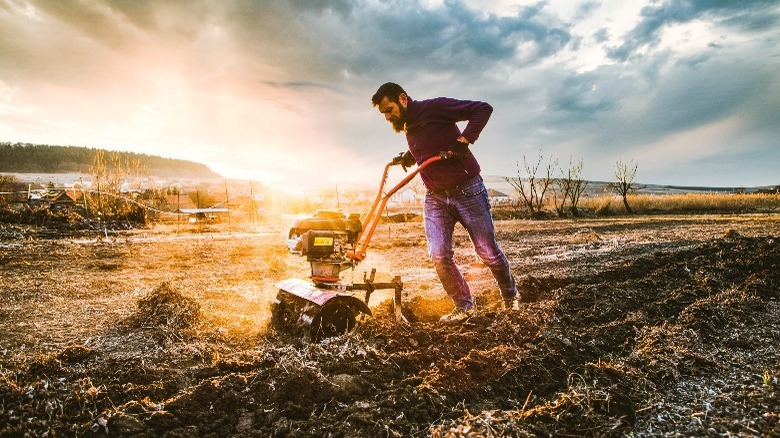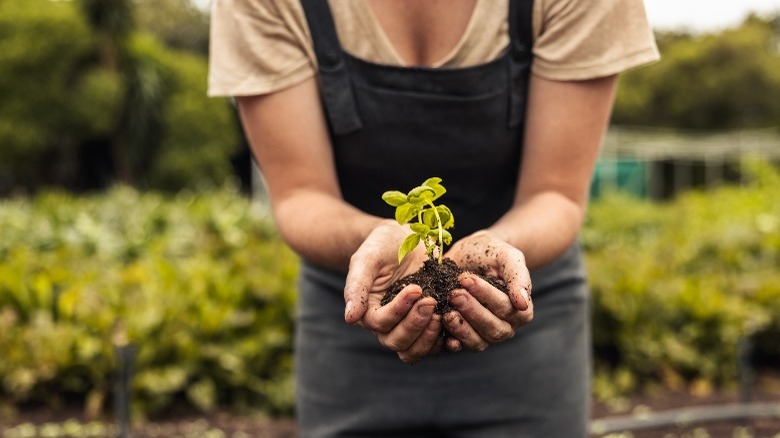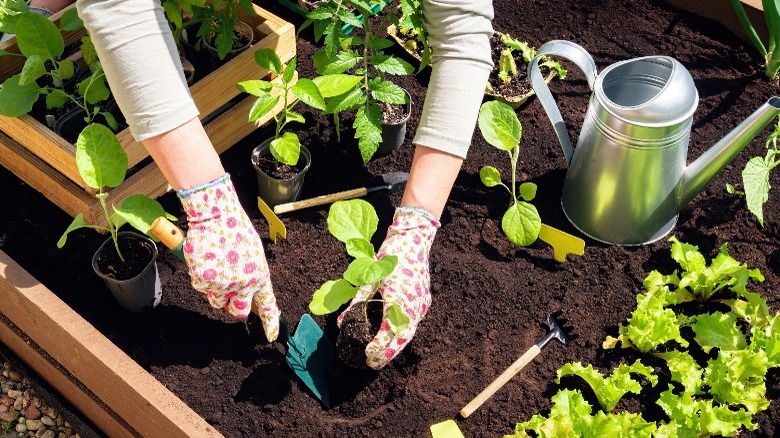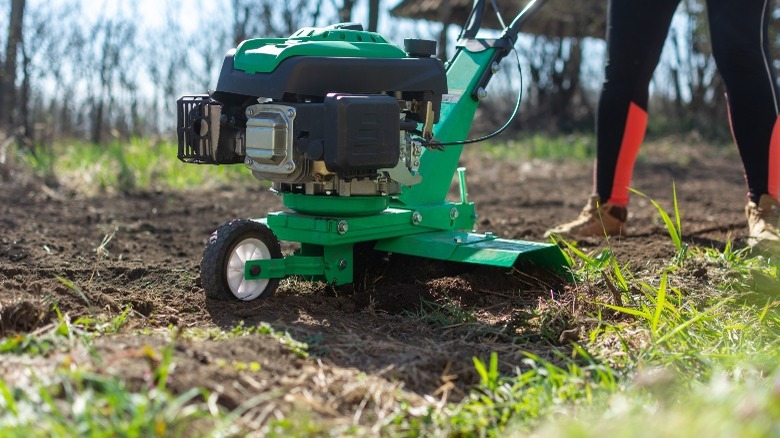What You Need To Know Before Purchasing A Garden Tiller
We may receive a commission on purchases made from links.
A woman taking up gardening was working diligently on her rows when her husband came home for lunch and asked her what she was doing. She told him, "I'm alphabetizing my herbs." He said, "I don't know how you find the time!" To which she replied, "It's right next to the sage."
Clever, wasn't it? Ok, maybe just a little corny. In any case, starting a vegetable garden is no joke. In addition to a green thumb, it takes a lot of time, energy, and care. But with the proper attention, the rewards are sweet. There's just nothing like growing your own food, and nothing tastes quite as sweet as something picked fresh from your own garden. If you've ever grown anything, you understand that it's a connection with the earth and with mother nature.
The importance of soil in our garden cannot be overstated, and tilling the soil helps improve our chances of growing healthy crops (via Bean Growing). Is the ground you're working with rocky and hard to break up? If you're just starting a garden, you'll want to till the ground first. This will aerate the soil and break it up so it's easier to work with. But isn't a garden tiller quite a big purchase? How often will you need to use it to make it worth the investment? You've come to the right place to find out, as we get ready to delve into everything you need to know about garden tillers and tilling your garden!
What's a garden tiller used for?
If you're getting ready to start a vegetable garden, you probably know there's not much more important than the soil that you plant it in. According to Angi, a garden tiller, also commonly known as a rototiller, is a machine that's typically either electric or gas-powered and has rotating tines, which make preparing the soil much easier. Many of us have dirt on our property that is rocky and hard, and sometimes full of clay, once you start digging. Especially when deciding to grow vegetables, you'll be using a large amount of space, and whenever you're starting an endeavor like this, it's advised to till the soil. Tilling breaks up the dirt and gets to the healthy, nutrient-rich soil beneath. Doing this task, made simple by a rototiller, will ensure a healthy garden plot for your plants.
Flora Explorer says that planting anything in compact soil is an exercise in futility because water and oxygen can't flow into the roots, or allow them to thrive and grow freely. Since this is a vital part of growing healthy plants of any kind, tilling the soil is an important step when planting a garden. It turns hard clumps of dirt into loose, aerated soil. This prepares the ground for optimal growing conditions, giving your garden the best chance of producing ideal results. Additionally, tilling helps get rid of weeds and their roots from the area completely and efficiently. This way, there's less chance of them coming back from roots left in the ground.
Depending on where you live, tilling is typically best done in the fall. This allows you to mix things like dried leaves and organic yard waste into the soil so they can decompose over the winter months, adding valuable nutrients. If you're in a cold climate, you'll want to get this chore done before the ground freezes and hardens. However, if you need to wait for spring, your garden can still reap the benefits of freshly loosened soil. Just wait a few weeks for the soil to balance out before planting seedlings.
What is a front tine tiller?
According to VeggieHarvest.com, one variation is called a front tine tiller, so named for its forward rotating tines in the front of the machine. This tiller is a little intimidating, as it has a tendency to get out of control for inexperienced users. It has a lot of power that takes leverage and strength to control. Both propulsion and tine depth must be manually controlled by the operator. The front tine tiller can also be more difficult to use for rocky or virgin soil. However, it is a less expensive choice and features more simple operation than rear-tined options.
According to Urban Farmers, front tine tillers are a perfect choice for small to mid-sized gardens. One feature gardeners like about front tine tillers is that you can adjust the width of the tines, usually from three settings. This allows for the adjustment of a large variety of spaces, measuring up to two feet wide. Many gardeners prefer front-tine tillers because they're easier to maneuver in compact gardens. Mid-tine tillers are very similar to front-tine tillers, with the tines placed further back, more directly below the engine (via For Construction Pros.com). Both are perfect for breaking up, loosening, and aerating the soil, weeding, and general soil maintenance.
What is a rear tine tiller?
On the flip side, according to Orscheln Farm & Home, a rear tine tiller is ideal for especially hard or rocky soil, as its wheels are engine-powered and separate from the tines. You can even get one with counter-rotating tines, which means the wheels turn in the opposite direction of the tines, a helpful feature when the ground really presents a challenge. These machines have adjustable depth regulators for tilling the ground at different and deeper levels, perfect for those that work with diverse types of soil. There are safety shields in the back and on the sides of the machine to protect the user as well.
House Grail points out that with rear tine tillers, the motor is in the front, while the tines are in the back, giving the user more control. Rear tine tillers do more work with less user effort than other options, but they also cost more money. They're advised for large gardens or plots, where there's more area to cover. Additionally, this is the machine recommended for ground referred to as virgin or unworked, that's never been tilled before. You can cover a large area more quickly and far deeper than with a front tine tiller. However, it's not able to maneuver smaller or intricate areas well.
Garden tiller vs. cultivator
A cultivator differs from a tiller, although cultivators are often referred to as mini-tillers, according to Mowers Direct. While a tiller is used to break up the dirt, a cultivator is used to thoroughly work it into a finer consistency and to thoroughly mix in fertilizers and compost. You can use this tool for weeding, as well. Cultivators are less powerful than garden tillers and they can be electric or gas-powered. A cultivator can be a very handy tool to quickly mix up soil and keep it loose and healthy all season long.
Cultivators are ideal for more precise work and are best for smaller gardens or areas (via Troy-Bilt). Additionally, it's important to differentiate between the two kinds of jobs these two different tools are made for, so as not to interchange them. Basically, you'll want to use a tiller to break new ground, but once that's been done, you might want to consider purchasing a cultivator. This is a handy tool to refresh established plots and get them ready for planting each spring.
Rear tine vs front tine
According to The Laughing Seed, the size and direction of the tines are extremely important to the task at hand. A lot depends on the size of your garden, as well. For a front tine tiller, keep in mind the tines propel the machine forward, and it has only small tires for stabilization. The engine is not as powerful, but it can be more easily manipulated in tight spaces. Additionally, it's a more lightweight tool and can be stored or transported easier. Front tine tillers come in battery-powered versions that are even more lightweight and cord-free. If you have an area measuring less than about 5,000 square feet, a front tine tiller is probably the way to go.
For larger areas, rear tine tillers are typically better and there are plenty of varying options. A rear tine tiller has tines that move either frontwards or backward, but you can get one that has dual rotating tines and counter-rotating tines. This means that by the tines rotating in opposite directions, the machine can accomplish the job more efficiently. Some pricier models give you the ability to adjust the torque and speed, as well. Rear tine tillers are also the best option if you plan to tackle rocky soil or would like to till deeper into the ground.
Should you buy or rent a rototiller?
The question of whether to buy or rent a rototiller is really an individual one and will depend totally on your specific needs. According to Professor's House, when you're in the market to buy a tiller, the important things to consider are size, type, power, and warranty. Keep in mind that prices vary greatly, and depend on so many different factors.
However, as Kyle's Garage points out, renting a low-end tiller runs about $86 per day on average. There are also issues that can occur when renting to consider. For example, these machines vary so widely in quality and even construction, that you might find a rented tiller difficult to work with. It may take you longer to complete the project than you estimated, costing significantly more than you originally planned.
In fact, depending on the weather, the hardness of the soil, and the size of your area, your project might take a week or even longer. Also, keep in mind when you rent a tiller, you'll be hurrying to finish the project, rather than taking your time with a task you might still be learning to do. However, if you only plan to use a tiller a handful of times a year, it might make more sense to rent one. Plus, then you won't have to worry about storage or maintenance for a machine you only plan to use rarely.
Disadvantages to tilling
Since you are likely considering the purchase of a garden tiller, it should be noted there are disadvantages to tilling, according to Sunday Gardener. Especially with a small or medium-sized garden, tilling can actually compact the soil over time. This is mainly because of having to walk either behind or beside the machine, which compacts the soil you've just broken up. Tilling these small areas by hand is the better choice as you can move backward as you work.
Next, tilling can actually create more weeds than it removes. By churning up the ground, a tiller inadvertently brings weed seed to a level and soil condition that more easily sprouts up. Additionally, the seed is distributed throughout your garden and easily multiplies the number. Of course, this is not the desired effect and can be avoided by skipping the rototiller altogether.
The other main problem with rototilling is the increase of bare or exposed soil. This unprotected soil can more easily erode. To prevent this, cover up the dirt between rows after planting. A layer of a material like straw can provide a barrier to keep your soil in place. Even in wintertime, a cover crop can help protect your soil from erosion and keep it better intact for spring.
Alternatives to tilling
Ok, so you're probably wondering, how can you achieve the results you want without tilling your garden? Well, according to Milorganite, it's called having a no-till garden, and it's a process that starts with planning well in advance. You start first by smothering the garden plot area, using newspaper or cardboard to kill off any existing grass, weeds, or other plants. Then, you add organic material such as leaves or compost and top with a layer of shredded wood chips. This layer of matter will break down to add nutrients to the soil beneath, and this process can be accelerated using a nitrogen-based fertilizer. Next, you'll need to soak the entire thing down with water, taking care to penetrate all layers well. Continue to keep the plot moist over the next several months as the layers break down. Then you'll have a nutrient-rich layer of soil ready for planting — no tilling necessary!
Additionally, there are a couple of other alternatives (via J&R Pierce Family Farm). One of these is using raised garden beds. Considered a simplified way of gardening, this is actually a preferred method for many because it's much more manageable. If space is a consideration, raised beds work very well and don't require tilling. Once you've added the soil composition you want, just add more each year as needed.
You can also grow a cover crop like winter peas, ryegrass, or red clover at the end of the growing season. These plants cover the garden and prevent weeds or grass seedlings from emerging. It also adds healthy nitrogen to the soil and the cover crop can simply be turned over and buried when it's time to plant in the spring.
The best garden tillers 2022
Ok, assuming you still want to purchase a tiller, let's talk brands. According to Garden Gate, the best overall garden tiller is the TJ604E Sun Joe Electric Tiller. With this model, you can quickly till rows up to 16 inches maximum. It can also maximize aeration as it reaches depths of up to 8 inches. This highly-rated machine sells for around $110 (via Amazon). The TACKLIFE Advanced Tiller is another quality option. This economical tiller can cultivate rows from 13 to 18 inches wide and up to 8 inches into the soil. Both of these tillers have good reviews and provide at-home gardeners with budget-friendly options for prepping their plots.
On the other hand, Mowers Direct, lists the Mantis #7940 as their top choice, with a cost of around $400. This is a durable option that's praised for its easy start and comfortable handles for operation. The Earthquake MC43 Mini Cultivator is another top pick that's a good choice for smaller areas. This lightweight model is easy to maneuver and is designed to loosen various types of soil.
The key to purchasing the right tiller is weighing the desired features with your budgeted price point. Do your research on finding the best value that can meet your garden's specific needs and look carefully at specifications and warranty information. Then, use your new tiller to take the health of your garden's soil to the next level.
